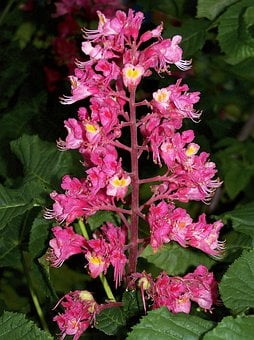The attractive Aesculus × carnea (red Horsechestnut) tends to be a mystery− its origins are unconfirmed and a subject of controversy among arborists and researchers alike. Some sources claim the origins lay in 1820 Germany, while others in 1858 France, and there may be additional claims we are forgetting to mention. Regardless, most experts believe it to be a hybrid between the Aesculus hippocastanum and Aesculus pavia (the European horsechestnut and the eastern North American native).
The Aesculus genus includes both Buckeyes and Horsechestnuts. This horsechestnut is best known for its vivid, large, and upright red flower clusters that you’ve likely seen blooming recently.
A likable tree of gardeners and landscape designers, the Red Horsechestnut has a nice shape and is shorter than the common horsechestnut, growing no more than 50 feet. It prefers full sun and does best in moist, well-drained, acidic soils. It tolerates salt, wind, and some drought. For these reasons, the tree is well adapted to the urban and suburban environment and even endures some compaction. Some claims of lifted sidewalks have been observed with this species, so it may be best to plant the tree in a park or garden setting or large tree lawn. There are no major pests or diseases to report with this species. Generally, the tree also requires little pruning to keep a good shape, making it a lower maintenance option.
As with most Aesculus, this tree features broad leaves of 5-9 dark green leaflets which radiate out from a central point. This central point is also where you will find the glorious ruby or scarlet red flowers erect into an impressive 10 inch panicle or cluster, towards the top of the branches.


